You’ve probably noticed how certain spaces feel electric when music plays, but there’s actual science behind making your room literally light up with sound. Sound-activated LED systems capture audio frequencies and translate them into synchronized visual displays that pulse, fade, and dance with every beat. Whether you’re hosting a party or simply want your daily playlist to create an immersive atmosphere, the technology exists to transform any space into a responsive environment that amplifies your music’s emotional impact.
Sound-Activated LED Technology for Dynamic Home Environments
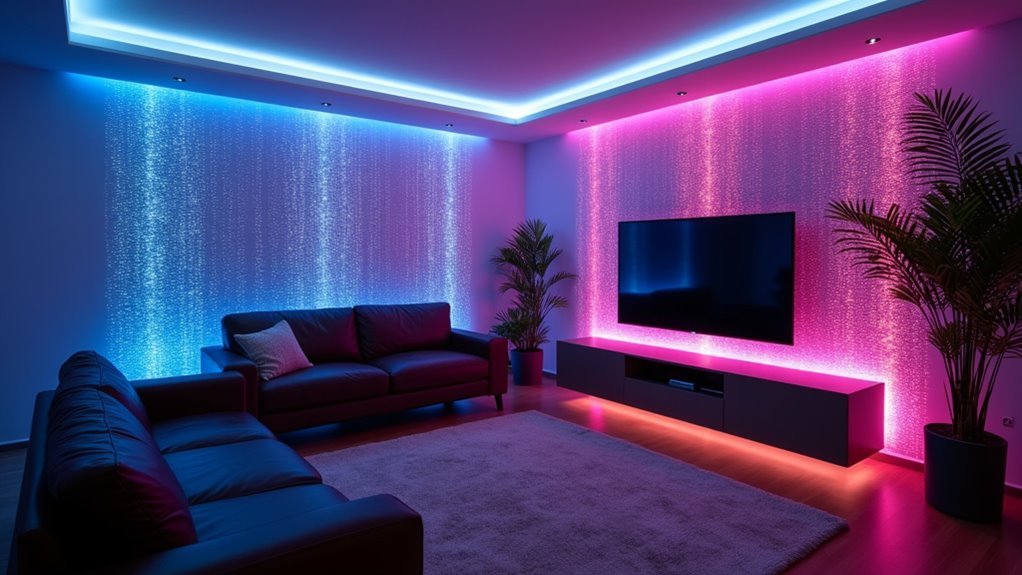
When music fills your space, sound-activated LED technology transforms those audio waves into mesmerizing light displays that dance in perfect harmony with every beat.
You’ll discover that these innovative systems use built-in microphones to capture auditory stimuli from both music and speech, creating dynamic visual experiences that respond instantly to sound.
With 12 vibrant color options and adjustable programs at your fingertips, you can customize lighting effects to match any mood or occasion.
Twelve stunning colors and programmable settings let you craft the perfect ambiance for every moment and gathering.
Whether you’re hosting parties, engaging in creative activities, or creating calming environments, sound-activated LED technology delivers up to 30,000 hours of energy-efficient performance.
This transforms your standard room into an interactive space where light and sound work together seamlessly.
Creating Multi-Sensory Experiences Through Automated Light Responses
You’ll discover how sound-triggered visual responses create enchanting environments where every beat and melody transforms into vibrant light displays.
Interactive color programming lets you customize these experiences with 12 different color levels and adjustable programs that respond to your voice, clapping, or musical instruments.
These automated light responses offer significant sensory integration benefits, especially for children with ADHD or sensory processing disorders who thrive on multi-sensory stimulation.
Sound-Triggered Visual Responses
Sound-activated LED lights transform any ordinary space into an interactive wonderland that responds directly to your voice, music, and movements. These innovative systems use built-in microphones to detect sound levels, creating mesmerizing sound-triggered visual responses that react to every clap, whisper, or song you produce.
You’ll discover 12 vibrant color levels and adjustable programs that offer endless lighting options for personalized experiences.
Whether you’re encouraging speech development in children with ADHD, autism, or sensory integration disorders, these lights provide therapeutic benefits through engaging multi-sensory play.
With an impressive 30,000-hour lifespan, you won’t worry about frequent replacements. Each vocalization triggers unique light patterns, promoting creative expression while building an immersive environment that makes every sound a visual celebration.
Interactive Color Programming
Interactive color programming takes these sound-responsive capabilities further by letting you create customized multi-sensory experiences that transform your environment into a personalized light symphony.
This advanced lighting system offers 12 vibrant colors with adjustable programs, allowing you to match light patterns precisely to your music or activities. You’ll discover that experimenting with different sound inputs—whether clapping, singing, or playing instruments—triggers unique visual responses that encourage vocalization and speech development.
The system proves particularly beneficial for children with ADHD, sensory integration disorder, or autism, fostering interactive engagement through playful light displays.
With LEDs lasting up to 30,000 hours, your interactive color programming investment provides long-term sensory stimulation while creating dynamic visual displays that respond seamlessly to any audio input you choose.
Sensory Integration Benefits
When children interact with sound-activated lighting systems, they’re experiencing powerful sensory integration that connects their auditory actions with immediate visual feedback.
This synchronized response helps children with sensory integration disorders, ADHD, or autism develop essential communication skills through engaging play.
You’ll find these innovative lighting ideas particularly effective because they encourage vocalizations through dynamic color displays.
When your child sings, claps, or speaks, they’ll see immediate visual responses across 12 vibrant color levels. This creates a multi-sensory environment where auditory input directly influences visual output.
The adjustable programming features let you customize experiences for different developmental needs.
With up to 30,000 hours of LED lifespan, you’re investing in long-term sensory support that grows with your child’s developmental journey.
Programming Your Smart Lighting System to React to Audio Frequencies
Programming your smart lighting system to react to audio frequencies transforms your space into a dynamic visual canvas that dances with every beat. You’ll find that smart lighting systems like Philips Hue offer customizable sensitivity settings, letting you fine-tune how your lights respond to different sound inputs. Built-in microphones enable real-time interaction, creating immersive environments tailored to specific frequencies.
| Sound Profile | Light Response | Color Effect | Intensity Level | Best Use |
|---|---|---|---|---|
| Bass Heavy | Pulsing | Deep blues/reds | High | Parties |
| Classical | Flowing | Warm whites | Medium | Relaxation |
| Electronic | Strobing | Bright colors | Variable | Gaming |
| Jazz | Smooth | Cool tones | Low | Ambient |
| Rock | Sharp | Bold colors | High | Entertainment |
Companion apps provide frequency visualizations, helping you understand how different sounds create unique lighting patterns throughout your room.
Essential Equipment for DIY Music-Synchronized Lighting Setup
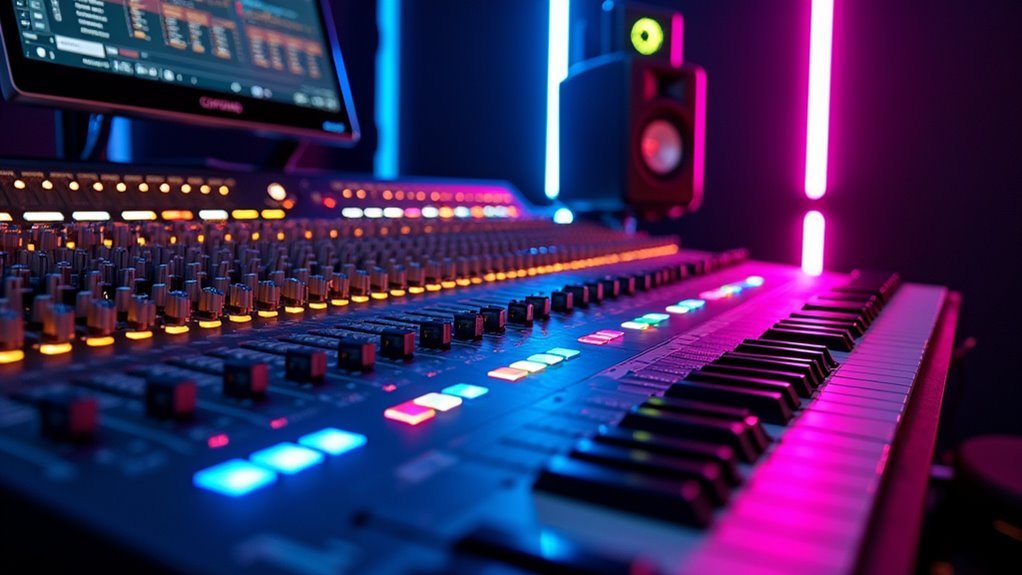
Five core components form the foundation of any successful DIY music-synchronized lighting setup, starting with sound-activated LED lights equipped with built-in microphones that capture audio input in real-time.
Sound-activated LED lights with built-in microphones form the essential foundation for capturing real-time audio input in DIY lighting setups.
You’ll need programmable LED strips offering multiple color options and adjustable programs that sync with your music’s mood and tempo. These essential LED lights provide up to 30,000 hours of performance, eliminating frequent replacements.
- Sound-activated LED lights with built-in microphones for audio responsiveness
- Programmable LED strips with customizable color options and tempo settings
- Dimmer switches and smart lighting controls for intensity adjustments
- Compatible sound equipment tested for interference-free operation
You’ll also want dimmer switches and smart lighting systems that enable individual control over light intensity and color settings.
Test your lighting coordination with sound equipment to prevent interference and guarantee peak performance during music playback.
Choosing the Right Color Temperature for Different Musical Genres
You’ll want to match your lighting’s color temperature to your music’s genre for the best atmospheric effect.
Warm 2700K lights create an intimate jazz club vibe, while cool 6500K blues energize electronic dance sessions and keep you alert.
Rock music benefits from dynamic color-changing LEDs that can shift between vibrant hues to match the genre’s intensity and emotional range.
Warm Lights for Jazz
When jazz fills a room, warm light becomes your secret weapon for creating the perfect ambiance.
You’ll want to choose bulbs with a 2700K color temperature that cast a soft, yellowish glow, reducing glare while letting you focus on every musical nuance. This cozy atmosphere perfectly complements jazz’s relaxed, moody nature.
Consider these essential warm lighting elements for your jazz sessions:
- Install dimmable LED lights to adjust brightness based on the music’s energy level
- Use amber or soft gold decorative lighting for artistic flair that matches jazz’s warm tones
- Create candlelight-mimicking ambient lighting for that classic jazz club feel
- Position lights to eliminate harsh shadows while maintaining intimate atmosphere
You’ll discover how warm light transforms your space into an inviting sanctuary where jazz truly comes alive.
Cool Tones for Electronic
Electronic music demands a completely different lighting approach that matches its high-energy, futuristic essence.
You’ll want to embrace cool lighting around 6500K to enhance alertness and focus, perfectly aligning with the genre’s energetic nature. Blue and white tones create an immersive atmosphere that complements electronic music’s synthetic, futuristic sounds.
When you’re performing or producing, cool lighting stimulates creativity and elevates intensity during your sets.
These cooler temperatures make LED displays more vibrant and dynamic, enhancing the visual impact of your electronic music events. You’ll notice how this combination influences listener engagement, creating an energetic vibe that encourages movement and interaction.
Cool tones don’t just illuminate your space—they transform it into an electrifying environment that amplifies your music’s technological edge.
Dynamic Colors for Rock
While electronic music thrives in cool blues and whites, rock music demands an entirely different visual approach that captures its raw, rebellious energy.
You’ll want to embrace dynamic colors that match rock’s intensity and power. Cooler blue tones around 6500K enhance energy and alertness during performances, but don’t stop there. Rock truly comes alive when you incorporate vibrant reds and purples that sync with energetic beats and powerful riffs.
Sound-activated lighting that responds to your music’s rhythm creates visually stimulating experiences mirroring rock’s dynamic nature. Studies show bright, contrasting colors enhance audience engagement and excitement during rock performances.
- Use cooler blue tones (6500K) for enhanced energy
- Incorporate vibrant reds and purples matching beats
- Install sound-activated lighting responding to rhythm
- Choose bright, contrasting colors for maximum engagement
Voice Control Integration With Smart Lighting Scenes
As technology continues to evolve, voice control integration transforms how you interact with smart lighting during your music sessions.
You’ll find systems like Philips Hue seamlessly compatible with Amazon Alexa and Google Assistant, enabling effortless hands-free operation. Simply speak commands to activate pre-programmed scenes that match your music genres or playlists, setting perfect atmospheric colors and brightness levels.
You can synchronize your lighting with music beats, creating dynamic visual performances that react in real-time to sound inputs. This makes your environment incredibly immersive without breaking your creative flow.
Whether you’re producing music or relaxing to your favorite songs, voice control integration lets you adjust lighting instantly while maintaining focus on what matters most – your musical experience.
Microphone Placement Strategies for Optimal Sound Detection
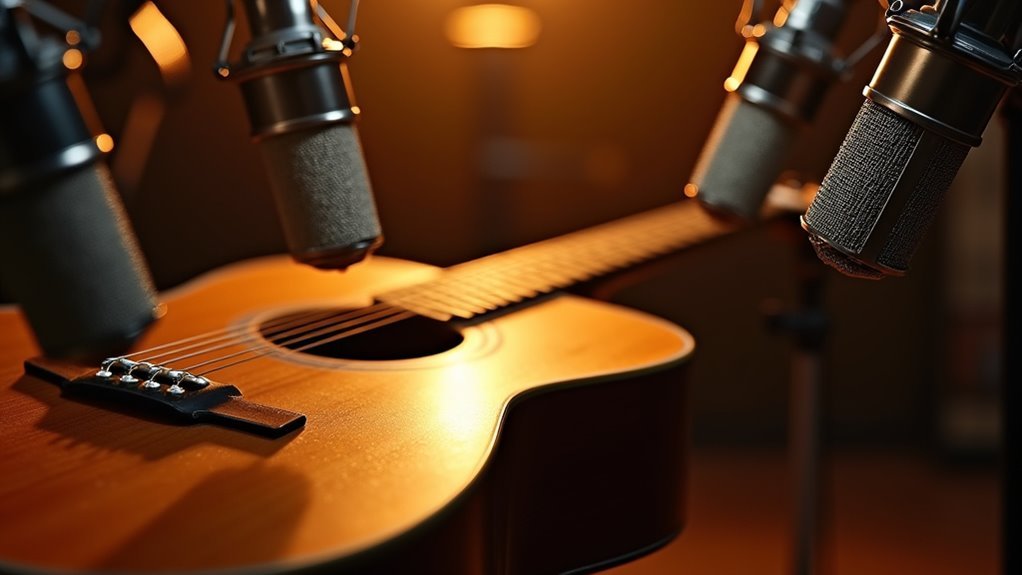
When you’re setting up music-reactive lighting systems, proper microphone placement becomes essential for achieving accurate sound detection that triggers seamless visual responses.
Your microphone placement strategies directly impact how well your lighting design responds to musical nuances. Position your microphone 6 to 12 inches from the sound source to capture vocal details while minimizing unwanted background interference.
Strategic microphone positioning within 6-12 inches of your sound source ensures precise lighting responses to every musical detail and vocal nuance.
You’ll want to experiment with different angles and heights, as placing the microphone slightly off-axis reduces harshness and improves tonal quality.
- Use a pop filter to reduce plosive sounds and protect against moisture damage
- Install a shock mount to isolate vibrations and eliminate handling noise
- Choose directional microphone patterns like cardioid to focus on your sound source
- Test various positioning angles to find the sweet spot for your lighting triggers
Energy-Efficient LED Solutions for Continuous Music Lighting
Effective microphone positioning captures the audio signals that drive your lighting system, but the visual components themselves require smart technology choices to maintain performance throughout long recording sessions. LED solutions deliver exceptional energy efficiency, consuming 80% less power than traditional incandescent bulbs while providing up to 30,000 hours of continuous operation.
| Feature | Benefit | Impact |
|---|---|---|
| Sound-Activated Response | Dynamic lighting displays | Enhanced musical experience |
| Adjustable Color Temperature | Customizable environment | Promotes creativity and focus |
| LED Strip Integration | Versatile accent lighting | Highlights room features |
Your room’s lighting transforms with sound-responsive LEDs that create interactive displays engaging both artists and listeners. Strip lights add versatility while maintaining low heat output, ensuring comfort during extended sessions without compromising your creative flow.
Customizing Light Patterns Based on Musical Tempo and Rhythm
While energy-efficient LEDs provide the foundation for continuous operation, the real magic happens when you customize light patterns to match your music’s tempo and rhythm.
Sound-activated LED lights transform any space by responding dynamically to volume and pitch changes, creating an immersive visual experience that mirrors your music’s energy.
Using the built-in microphone, you can clap or sing to trigger specific displays that sync with your song’s tempo. The adjustable color programs and intensity levels provide a visual representation of musical dynamics, making your lighting work as both ambiance and task lighting.
- Clap or sing to activate tempo-synchronized light displays
- Adjust color programs to match musical dynamics and energy
- Use microphone sensitivity to respond to volume changes
- Create unique patterns for different sound inputs and rhythms
Troubleshooting Common Issues in DIY Sound-Responsive Systems
When you’re building your own sound-responsive lighting system, you’ll likely encounter two frustrating issues that can ruin the magic of synchronized lights and music.
Your microphone might struggle with sensitivity problems, failing to pick up quieter sounds or overreacting to loud noises, while your LEDs could suffer from response delays that make them flash out of sync with the beat.
These problems can transform your carefully planned light show into a disappointing display, but they’re fixable with the right approach.
Microphone Sensitivity Problems
Since dynamic microphones typically exhibit lower sensitivity than their condenser counterparts, you’ll often encounter frustrating situations where your sound-responsive lighting system doesn’t activate as expected.
When your microphone sensitivity isn’t adequate, your lights won’t respond properly to music, creating disappointing results.
To resolve these microphone sensitivity problems, focus on these key areas:
- Position your microphone closer to the sound source to capture stronger audio signals
- Adjust gain settings on your preamp to boost sensitivity without introducing distortion
- Choose condenser microphones over dynamic types for better responsiveness in sound-activated systems
- Test various frequencies and volumes to identify which sounds trigger your lights most effectively
Background noise can also interfere with performance, so select microphones with excellent noise rejection capabilities for ideal results.
LED Response Delays
Even with proper microphone sensitivity, you might notice your LED lights responding a split second after the music hits. This delay stems from processing latency in your microphone and LED system. Position your microphone closer to the sound source and choose one with high sensitivity ratings for quicker detection. Built-in microphone systems sometimes aren’t optimized for rapid processing, creating noticeable lag.
| Issue | Cause | Solution |
|---|---|---|
| Slow Response | Low microphone sensitivity | Use high-sensitivity microphone |
| Processing Lag | Built-in system limitations | Upgrade to optimized hardware |
| Signal Interference | Poor wiring/electronic interference | Check connections, eliminate interference |
| Inconsistent Triggers | Inadequate testing | Test with clapping, singing, various sounds |
Regular testing with different sound inputs like clapping helps identify specific triggers causing delays, allowing you to fine-tune your system’s performance.
Safety Considerations for Automated Home Lighting Installations
Although automated home lighting systems can transform your living space into a responsive musical environment, you’ll need to prioritize safety throughout the installation process.
Your lighting plan should incorporate UL certified electronic components to meet compliance standards and minimize electrical risks. Professional installation guarantees proper outlet configuration and system functionality.
Key safety considerations include:
- UL Certification: Use only certified electronic components in your automated lighting setup
- Professional Installation: Hire qualified electricians for outlet work and system integration
- Regular Maintenance: Perform surface washing and air drying of equipment regularly
- Child Supervision: Always monitor children during interactive lighting features
If you’re installing systems in environments with children who’ve developmental challenges, consult pediatricians or therapists first.
These precautions guarantee your music-responsive lighting creates an enjoyable, safe experience.
Budget-Friendly Alternatives to Professional Concert Lighting
You don’t need to spend thousands on professional concert lighting to transform your space into a vibrant music venue.
DIY LED strip solutions offer incredible versatility at a fraction of the cost, while smart home lighting integration lets you sync colors and effects with your favorite tracks.
Affordable color-changing options like smart bulbs and battery-powered LEDs can create that concert atmosphere you’re craving without breaking your budget.
DIY LED Strip Solutions
While professional concert lighting can cost thousands of dollars, DIY LED strip solutions bring that same vibrant energy to your music space for under $50.
You’ll get access to 12 color levels and adjustable programs that create dynamic lighting effects. These strips install easily along ceilings, walls, or around your music equipment, transforming any room into an immersive audio-visual experience.
Sound-activated LED strips respond directly to your music, creating synchronized light shows that enhance creativity during practice or recording sessions.
With their impressive 30,000-hour lifespan and energy-efficient design, these diy led strip solutions offer long-term value while generating minimal heat for comfortable extended use.
- Choose from 12 customizable color levels and dynamic programming options
- Install effortlessly on ceilings, walls, or around musical equipment
- Enjoy sound-activated synchronization for interactive music experiences
- Benefit from 30,000-hour lifespan with energy-efficient, low-heat operation
Smart Home Lighting Integration
Smart home lighting systems like Philips Hue transform your music space into a concert-like atmosphere without breaking your budget. You’ll achieve professional-grade lighting effects through customizable color settings and dimming options that create dynamic scenes perfectly synchronized with your favorite tracks.
| Component | Function | Cost Range |
|---|---|---|
| Smart Bulbs | Color changing, dimming | $15-50 each |
| Smart Plugs | Remote control existing fixtures | $10-25 each |
| LED Strips | Accent lighting, sound-reactive | $20-60 per strip |
| Dimmer Switches | Automated scene control | $25-45 each |
Smart home lighting integration becomes even more exciting when you add sound-activated LED lights that respond to audio input. These affordable solutions create interactive visual experiences that pulse and change colors with your music’s rhythm, delivering concert-quality ambiance in your personal space.
Affordable Color-Changing Options
Although professional concert lighting systems cost thousands of dollars, budget-friendly color-changing alternatives can deliver stunning visual effects for under $100.
These affordable color-changing options transform any space into an immersive musical experience without overwhelming your budget.
LED strips and smart bulbs offer vibrant lighting effects that rival professional setups. Many budget-friendly models provide multiple color options and modes, creating dynamic atmospheres for different musical occasions.
Sound-activated features respond directly to your music, generating interactive experiences that enhance every beat and melody.
Key benefits of affordable lighting solutions:
- Energy-efficient LEDs reduce electricity costs while lasting up to 30,000 hours
- Remote-controlled dimmers enable instant customization
- Smart lighting systems integrate seamlessly with music
- Multiple color modes create versatile ambiance options
You’ll achieve professional-quality results while maintaining complete control over your lighting experience.
Expanding Your System: Adding Multiple Rooms and Zones
As you contemplate taking your audio experience beyond a single room, expanding to multiple zones transforms how music flows through your entire living space.
A multi-zone audio system from brands like Sonos or Bose gives you centralized control over sound levels and sources in each room. You’ll customize environments independently or sync playback throughout your home.
Smart lighting systems enhance this setup by reacting to your music, creating dynamic atmospheres that encourage engagement.
Smart lighting that pulses with your beats transforms any room into an immersive entertainment experience.
LED lights with sound-activated features provide visual feedback that complements your audio experience, especially in entertainment or relaxation spaces.
Remember to evaluate each room’s acoustic properties when placing speakers.
Different materials and layouts impact sound quality, so you’ll need tailored placement for best clarity in every zone.
Maintenance Tips for Long-Term Sound-Activated Lighting Performance
Once you’ve invested in sound-activated lighting, protecting that investment requires consistent care and attention to detail. Regular maintenance guarantees your lighting would continue responding accurately to music and environmental sounds for years to come.
- Clean regularly – Surface wash your unit with a damp cloth and air dry to maintain appearance and functionality without damaging internal components.
- Maintain the microphone – Keep the built-in microphone free from dust and debris to preserve its sensitivity and sound response capabilities.
- Control storage environment – Store in climate-controlled conditions to prevent damage from extreme temperatures or humidity that could shorten lifespan.
- Follow manufacturer guidelines – Consult recommended maintenance schedules and consider professional servicing for peak efficiency, remembering LED lights last up to 30,000 hours.
Frequently Asked Questions
How to Get Lights to Match Music?
You’ll need sound-activated LED lights with built-in microphones that detect music’s volume and pitch. Choose lights offering multiple programs, twelve color levels, and smart controls for customizing brightness and temperature matching your music’s mood.
How Do Music Lights Work?
Music lights work through built-in microphones that capture your audio input, whether you’re clapping, singing, or playing music. The sound-activated technology instantly triggers colorful LED displays that respond to volume changes and rhythm patterns.
What Lights Sync With Music?
You’ll find sound-activated LED strips, smart bulbs like Philips Hue, and disco lights that sync with music. These lights use built-in microphones to detect beats and create colorful displays.
What Is the Best Music Reactive Lighting?
You’ll want sound-activated LED lights with built-in microphones, adjustable programs, and multiple vibrant colors. Look for 30,000-hour lifespans and UL safety certifications to guarantee long-lasting, safe performance during parties.

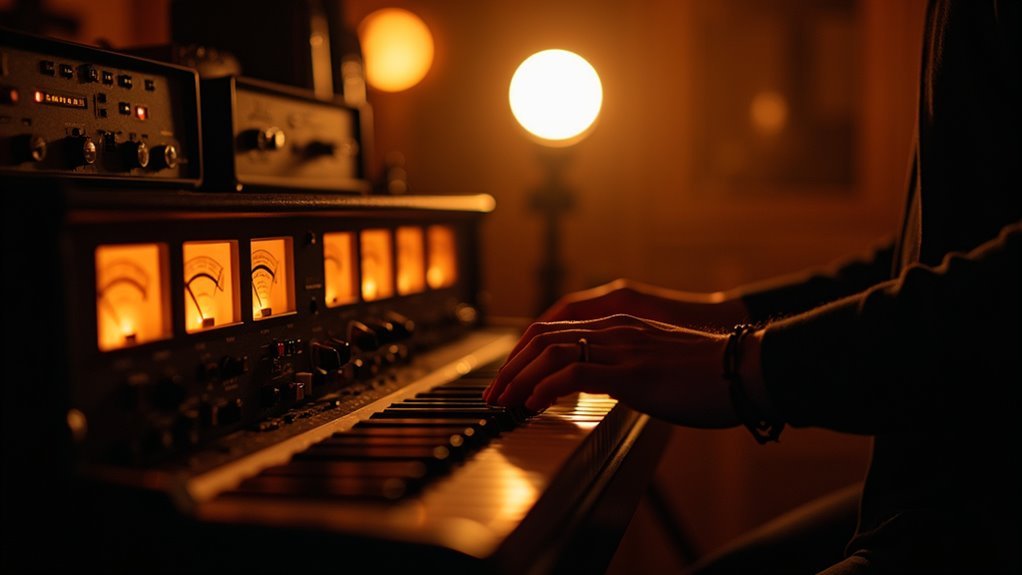

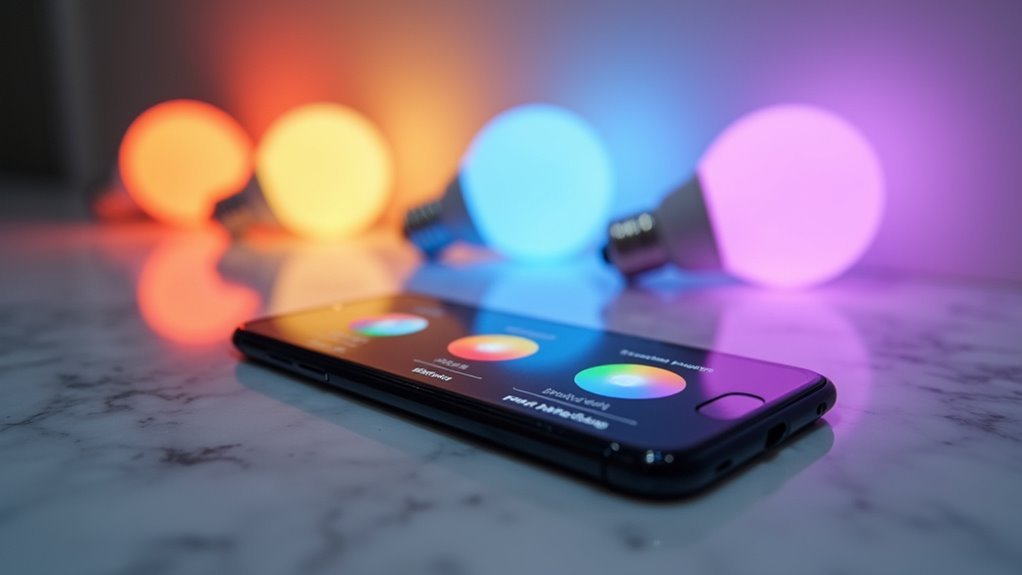
Leave a Reply